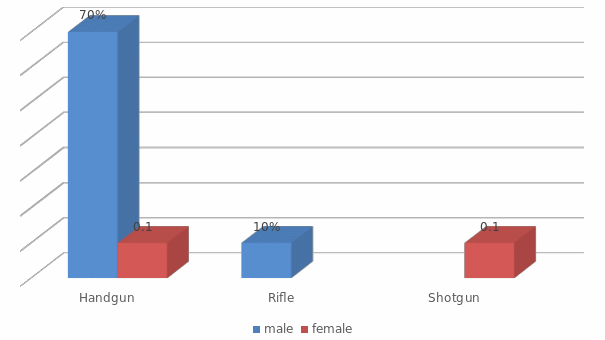The rate of juvenile gun violence is rather high in the USA. Koper, Woods, and Isom (2016) note that it is the second leading cause of death of people aged between 15 and 24. Marano (2015) also notes that the problem is under-researched as many aspects of the issue are yet to be analyzed. This paper includes a brief analysis of a survey implemented and provides some recommendations regarding possible prevention policies.
The mean age of the participants in the survey was 15.5. The vast majority of them were males (80%). As for the race, 40% of the participants were white, 40% were black, and the rest were people of other races. The majority of the participants (70%) reported that they had stolen the gun. More than half of the participants (60%) were under the influence of drugs when committing the crime. As for the type of weapons used, the vast majority of the participants (80%) had handguns. Interestingly, this type of gun was mainly used by males while an equal number of females used shotguns and handguns (see figure 1). It is noteworthy that 60% of the participants were involved in criminal activity for the first time.
It is possible to identify the major characteristics of adolescents using guns. It is clear that males use guns more frequently as compared to females. People of different races engage in such types of criminal activity. Notably, a preferable type of gun is the handgun, which should be taken into account when developing prevention policies and measures. The use of drugs is also a serious risk factor to take into account.

The information provided can be used to develop some recommendations concerning juvenile gun violence prevention. It is necessary to note that policies involving enforcement are less effective than those focusing on collaboration with other agencies and stakeholders (Koper et al., 2016). Collaboration is becoming a common component of various prevention programs. Thus, Forster, Grigsby, Unger, and Sussman (2015) claim that collaboration with the families of people at risk, schools, and communities is beneficial. Based on the data obtained, it is possible to recommend policymakers to focus on adolescent males who are mainly at risk of being involved in gun violence. It is also possible to develop a campaign raising awareness among gun owners. Parents should understand that when buying a handgun, they increase the chance of their child’s (most probably, son’s) engagement in criminal activity. Since the majority of the participants had not committed violent crimes before, it is necessary to pay more attention to adolescents who do not have a criminal record instead of focusing on ex-delinquents. Finally, it is vital to pay closer attention to students using drugs, as well as students suffering from some psychological and emotional issues (for example, depression). Social workers, teachers, and families should try to identify the change in an adolescent’s behavior and help the young person to cope with issues that occur.
On balance, it is possible to note that juvenile gun violence is a serious issue that needs to be addressed. Male adolescents are at a higher risk of engaging in this type of criminal activity compared to females. The use of drugs is another risk factor. To address the problem, it is possible to launch a campaign targeting gun owners and an intervention involving adolescents, schools, community, and parents aimed at helping adolescents cope with issues that can potentially lead to the drug use or violent behavior.
References
Forster, M., Grigsby, T., Unger, J., & Sussman, S. (2015). Associations between gun violence exposure, gang associations, and youth aggression: Implications for prevention and intervention programs. Journal of Criminology, 2015, Web.
Koper, C., Woods, D., & Isom, D. (2016). Evaluating a police-led community initiative to reduce gun violence in St. Louis. Police Quarterly, 19(2), 115-149.
Marano, D. (2015). Juvenile offenders and guns: Voices behind gun violence. New York, NY: Springer.